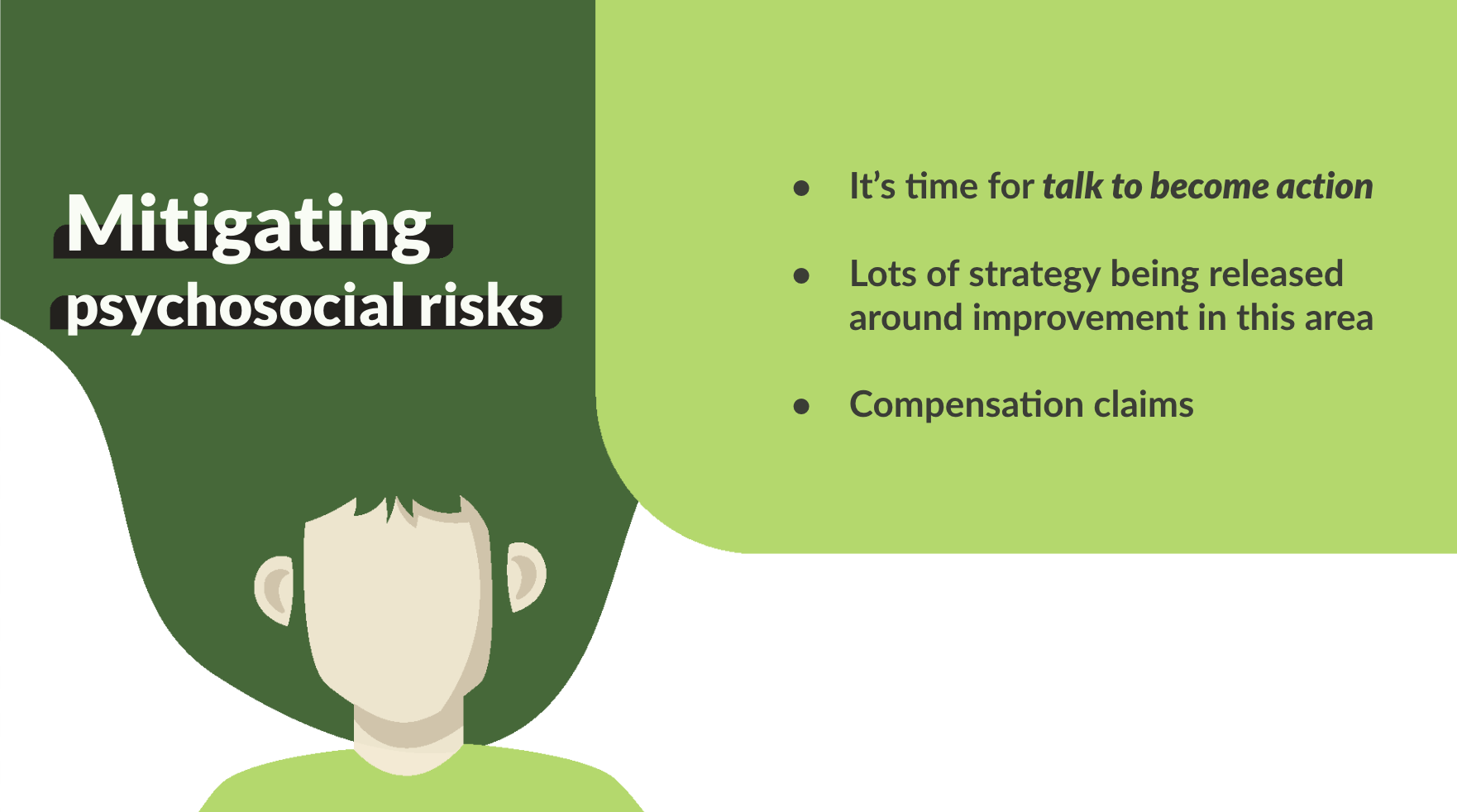It’s been well over a decade since New Zealand’s health and safety landscape was shaken to its core by the Pike River disaster, and yet fatality rates remain alarmingly high. Have we moved forward at all, or are we just treading water? As a nation now, we’re navigating through a mix of positive developments, emerging trends, and unsettling cutbacks in health and safety. From growing mental health awareness to reduced investments in safety personnel, the stakes are higher than ever. Amidst the challenges, new opportunities for engagement and innovation are shining through.
Journey with me over the next 2,000 words as we explore the current landscape of health and safety in New Zealand—where we stand, the obstacles we face, and how we can turn the tide towards a safer future for all.
These concepts are based on my recent presentation at ePIC—ecoPortal’s conference for health and safety leaders.
Get fresh H&S insights weekly
The State of a Thriving Nation
Since its release last year, the Business Leaders Health and Safety Forum “State of a Thriving Nation” report has been a powerful contemporary indicator of New Zealand’s safety performance, making it a perfect place to begin to understand where we’re at and where we can go.
Having been in the business of health and safety rep training for nearly ten years, I experienced an enormous sense of deja vu reading the report. I decided to look back at my first PowerPoint course presentation from 2015, which confirmed my suspicions: many of the statistics had not changed in over a decade.
Across that time, New Zealand’s fatality rate has remained 4–5 times the fatality rate in the UK and roughly double the contemporary Australian rate. While that is a rather unpleasant reality to face, this report’s commission shows a trend in the right direction, indicating a desire for real improvement.
Another positive outcome of this negative discovery is that the Forum has formed a small health and safety wellbeing systems task force to lead actionable inquiry into the sluggish and uncoordinated performance identified. That task force will ask what we want to and can achieve within a given time period.
Now understanding what’s realistically possible, and what’s left to learn to make more possible, the task force can put real strategies in place to achieve their goals. It’s the right set of people to make meaningful change and gain clarity in how we as a nation want to and can do better, and we should all be excited for what is going to come from it.

Investment Reduction
Meanwhile, we’re seeing increasing pressure on mid- to high-level health and safety managers, with news of significant redundancies and restructurings across regions within both the public and corporate sector.
Only a few years ago there seemed to be a glut of health and safety manager roles being advertised and nowhere near enough qualified or experienced people to fill them. Now every day I see more experienced, knowledgeable, highly qualified health and safety managers on LinkedIn looking for new roles, having been made redundant through merged business unit roles or changes in reporting structure, likely to save headcount and reduce costs.
The scariest thing about watching this reduced investment in health and safety personnel is that it can easily translate into cost-cutting measures applied to other health and safety resources like training, equipment, upgrades, and maintenance, which will flow on to affect worker engagement with health and safety systems and goals.
Why is this the case?
Is it a post-COVID downplaying of the health and safety function’s relevance? Perhaps. It might also speak to the distance of time from the Pike River Mine disaster, which so greatly spurred legislation. Or is it not enough new case law, not enough scary fines and prosecutions? Not enough front-page headlines of directors and CEOs going to jail?
The past eight and a half years of health and safety events has been a huge roller coaster of attention and energy. Each stage has brought surges and plateaus of focus, despite continued issues. With a new government, a new WorkSafe CEO and structure, the Forum taskforce, and anticipated WHS reform consultation, we are in the middle of another surge, but what will the actual outcomes and improvements be? Only time will tell.
The Mind Game
When discussing current trends in the health and safety industry, we can’t go past mental health and wellbeing, which is also a good place to reinvestigate the burden of harm. During my ePIC presentation, I asked the audience what percentage of workplace harm mental health issues constitutes. Answers ranged from 3% to 87%, showing the diverse perceptions of the issue.
In reality, 17% of workplace harm events are officially mental health issues. However, given how systematically under-reported mental health issues are, that statistic is more likely double, meaning that about a third of all workplace harm involves mental health or mental wellbeing.
Though many see workplace mental health and wellbeing as an emerging topic, there is so much guidance material out there now—so many webinars, case studies, and guides—that no one can plead ignorance any longer. Naivety is not an option, nor is putting your head in the sand and ignoring that it is an issue that needs to be addressed.
The governance and strategy coming out on this topic right now is based around how we can improve in this field. How can we go into the workplace, talk to people, understand the key risks that they are seeing and the key harm outcomes that are happening? And then what control mechanisms can we put in place to address that? Is it training? Support? Changes to workflow or work content?
When we’re looking at mitigating psychosocial risk, we're talking about changing the job demands, the environment, and the work that might be affecting safety in these terms. Any health and safety practitioner thinking to themselves, "that’s not for me to deal with": you’re going to get left behind.
This area is a huge focus for WorkSafe right now. ACC are looking at how mental health compensation claims fit into their system too. It’s only going to get busier in this space, so we as organisations need to stay ahead of this curve, from strategic governance on the part of the leadership team to management training, resource distribution, and more.

Engagement: The Shining Future of Safety
Engagement is a key piece of all the above puzzles, and is an important asset to have across all levels of an organisation. In particular at the moment, however, we are seeing a highly valuable increase in the desire of leaders, officers, and—to a smaller degree—directors, to be engaged in their health and safety system.
This is an awesome development, as engagement of leadership is absolutely critical to a strong safety culture. All the research out there agrees, observing that the more visible the leader is—the more they are out there walking the walk—the better the outcomes are likely to be.
We can see that in our own client base, which includes organisations with some really influential leaders. We see this through an increased demand from middle- to high-level senior managers for proactive lead indicator tools like safety observation templates, safety tours, leader walks, and safety conversations.
We offer those tools within the ecoPortal package of products, and the increased use of those tools makes me confident that we are seeing a shift in the officers and the senior managers. These groups are no longer solely relying on the monthly board report or their monthly health and safety report; they're getting more boots on the ground, which is the best way to engage.
The 2024 governance Good Practice Guide just published by the Institute of Directors (IoD) has focused on this as well, calling out the importance of management and board engagement and defining what good looks like in this space, in particular under the five core behaviours the guide outlines, curiosity is key. Be genuinely curious about what is happening in the organisation to understand:
1. The reality of how work is done.
2. What challenges your workers face.
3. What impact your decisions have on health and safety.
4. Whether systems are effective.
Engagement isn’t about more Zoom calls. It's not about more memos or more emails. It's not about more posters up around the lunchroom. It's about the officer getting down to the ground, putting on the high-vis vest and the steel caps, going to the site and talking to the team, finding out what the problems are, and helping fix them.
As recent ecoPortal webinar guest and Operational Risk Management Consultant Tim Hudson said, to really nail safety culture, leaders need to take that final step and actually be proactive in taking on workers’ challenges and being visible in addressing them.
Engagement is working to personally understand what worries a worker and using tools to capture this information. It’s gathering the risks they wouldn’t catch being offsite—those risks, shared in informal conversations, are often the risks that don’t have sufficient controls in place. Many leading indicators that should drive performance reviews, improvements, and monthly tracking can come from those records of proactive onsite conversations.
With some significant prosecutions underway, as well as some interesting new prosecutions in Australia with individual directors or officers named or implicated—we’re only going to see more pressure from leaders to provide proactive health and safety support.
Lead vs Lag Indicators
I’ve been watching with great interest the lead vs lag indicator discussion over the past couple of years. The anti-Total Recordable Incident Frequency Rate (TRIFR) brigade has been very vocal, demonising lag factors as old-fashioned, negative and past their use-by date. The new Institute Even the new IoD best practice guide agrees, recommending moving away from measures like TRIFR and Lost Time Injury frequency rate (LTIFR).
Yet at the same time, some global leaders I host in ecoPortal's Thought Leadership Webinar series defend TRIFR lag factors as an important part of their reporting elements. The majority of new ecoPortal clients also request variations of frequency reports as a key dashboard element of their event module.
While we have hopefully moved away from the old “It has been 79 days since our last accident” workplace sign, I would recommend a good balance of lead and lag to get the greatest insights possible.
Final words
In this evolving landscape of health and safety, we can't afford complacency. Every decision we make today will ripple through the future of New Zealand’s workforce. As we navigate the variables of our past and present, the path forward demands more than just keeping pace; it requires bold, innovative steps.
Are we ready to shape a safer, more engaged future? Or will we let these opportunities slip away?
The choices we make now will define the legacy we leave behind. What will yours be?




.png?width=352&name=Psychosocial%20Safety%20(2).png)

.png?width=352&name=Rethinking%20Health%20%26%20Safety%20in%20NZ%20(1).png)

